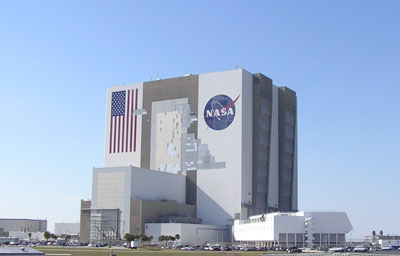NASA’s Florida infrastructure: the next generationby Taylor Dinerman
|
| Instead of trying to fix the VAB, it should be either torn down or preserved as a historic monument to the US space effort. |
In 2002 the Walker Commission on the Future of the US Aerospace Industry noted that “The Vehicle Assembly Building has sustained siding and bolt failures due to hurricanes and seasonal high winds. Its 35-year-old roof requires frequent external patching, and platforms and nets have been installed below the roof deck to catch falling debris. Overall the structure is badly deteriorated and severely corroded.” In the 1990s it was a notorious fact that funds appropriated for infrastructure repair and maintenance were often diverted to cover cost overruns on various major programs.
Avoiding these persistent problems should be one of NASA’s principal goals. This may mean that instead of trying to fix the VAB, it should be either torn down or preserved as a historic monument to the US space effort. A brand new VAB should be built, one designed to take the worst of the Florida climate and to be able to continue operations even in extreme weather conditions. In the long run this will save money by eliminating many of the predictably costly delays caused annually by hurricanes. Hardening the facilities at the Kennedy Space Center (KSC) is the sort of unglamorous expense that could pay dividends for many years or even decades to come.
A new VAB could be designed to take advantage of state-of-the-art communications and data processing technology. It would be possible to make the whole thing a state-of-the-art wireless, paperless facility. It would also be a good idea to design the building in such a way as to make future upgrades much easier than at the old VAB.
Building the in-line SDLV (let’s call it the “Big Stick”) is going to be pretty difficult: the aerodynamics of the system might seem easier than the shuttle “stack” with the side-mounted orbiter. Until some serious wind tunnel work and some very complex computer modeling and simulations are done, however, the nature of the challenge will still be a mystery. Even after this part of the development process is over there could still be a few nasty surprises lurking out there. It cannot be stressed too much that making the right investments now and over the next four or five years will save billions of dollars and maybe even the lives of future astronauts, who will depend on the SDLV to deliver vital supplies and equipment to the Moon and beyond.
| Since NASA will be using the SDLV for perhaps forty or fifty years it makes sense to build the support structures with that timeframe in mind. |
The SDLV system is going to need a new infrastructure, and while refurbishing the VAB may seem like a cost-effective solution, the alternative of a new building built expressly for the SDLV with all-new internal cutting-edge mating and manipulation machinery would help prevent costly delays and mistakes. One idea for a Mars mission requires launching six SDLVs over a six-week period; such tight scheduling leaving little room for error. Using the old and unreliable ground handling systems that NASA now has at KSC makes such a mission architecture difficult to imagine.
Since NASA will be using the SDLV for perhaps forty or fifty years it makes sense to build the support structures with that timeframe in mind. The current VAB is a valuable piece of property. The Florida Space Authority as well as some of this nation’s imaginative real estate investors will be able to find a suitable use for it after the final shuttle mission has returned to Earth. NASA should begin planning for the next generation of infrastructure now, and it should be upfront with Congress and the American people about both the short-term costs and the long-term benefits.
